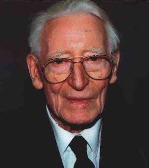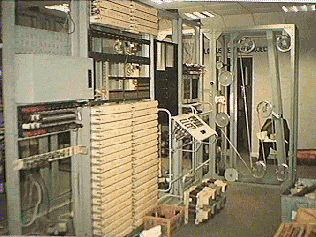Sir Thomas Flower's Colossus was a
descendent of automation technology he'd developed in the 1930's for the
British Telephone Establishment.
QUESTION: Did
Tommy Flowers' 10 Colossus Computers deployed by British Intelligence at
Bletchley Park save the free world? (the
ANSWER: YES!)
FEATURE
STORY
The Programmable Electronic Computer was
invented in Great Britain by Sir Harold Thomas Flowers in the 1930's
& early 1940's (NOT BY the UNIVERSITY of PENNSYLVANIA or Drs. ECKART &
MAUCKLEY as claimed! Their ENIAC was 2-3 years later than Flowers' and was the
first commercial "business" computer to be produced.) History has been altered by
opportunism. These remarkable facts and the
remarkable event of Tommy Flower's invention: COLOSSUS, a computer that very likely saved the world... have been lost in time,
buried behind Official Secrets Classification of the British Intelligence
Establishment for 55 years. Stubborn and false
marketing efforts by Unisys Corporation, the ACM and the University of
Pennsylvania. have led to allegations by the ACSA that the ACM and University
of Pennsylvania collaborated to commit a MISCONDUCT OF SCIENCE, disgracing
even the remarkable events surrounding ENIAC and Univac/Unisys. It's time to correct the record and honor the Father of the
programmable electronic computer: Sir Tommy Flowers. (READ
"COLOSSUS's REBIRTH |
THE CODE BREAKERS
)
While working as a lowly engineer at the British
Telephone Establishment, Tommy Flowers came up with the idea to use paper tape
and 'programmable switches' made of thermion valves (Vacuum Tubes) to create a
programmable device to automate the switching of telephone calls. While
he was unable to entirely automate the British Telephone Establishment with
it, in 1941, with Germany sinking American ships bearing supplies to England,
badly needed, Tommy convinced the famous Code Breakers at Bletchley Park
Mansion (Project Ultra) in England, to fund his effort to build a larger
model, dubbed "Colossus", to help decode the Lorenz Ciphers
that Germany was using with Teletypes, to send messages from Admiral Durnetz
to his U-Boat Commanders roving the waters of the North Atlantic, so that
Allied Convoys could steer clear of them. It took Tommy a mere six months to
complete his machine, and he set about, with the help of the Mathematicians
and Code Breakers of Bletchley Park, writing it's first programs to decrypt
the German ciphers of the Lorenz machines late in 1942. (U of
Penn's Eckart and Mauckley's "Eniac" came online for the first time
in 1946).
 By
early 1943, Tommy Flower's Programmable Computing Machine was completed AND
programmed, more Colossi were being built for more complex operations,
and it was in operation decoding encrypted German radio-teletype messages by
early 1944 at the top-secret location of Project Ultra:
Bletchley
Park (picture at right).
That was just as the University of Pennsylvania and it's pioneers, Drs. Eckley
and Mauckert, were first just STARTING to develop what later became known as
ENIAC (which spells the biblical name "CAINE" backwards, and was
finished in late 1945-46). Flower's Colossus was the world's
first Programmable Electronic Computer. By the end of the war, 10 of the
computers had been built for the British War Department, and they played an
extremely significant role in the defeat of Nazi Germany, by virtually
eliminating the ability of German Admiral Durnetz to sink American convoys, by
undermining German General Irwin Rommel in Northern Africa, and by confusing
the Nazis about exactly where the American Invasion at Normandy France, was
actually going to take place. Because of their involvement with
Bletchley Park, Colossus's capabilities were known to the United States
War Department's Intelligence Arm, who after seeing Colossus start
playing so crucial a role in military action against Germany in 1944, then
sought to have Drs. Eckley and Mauckert at University of Pennsylvania adapt
the concepts of Colossus's design to the building of the ENIAC, not to
minimize the remarkable work of Eckley and Mauckert.
By
early 1943, Tommy Flower's Programmable Computing Machine was completed AND
programmed, more Colossi were being built for more complex operations,
and it was in operation decoding encrypted German radio-teletype messages by
early 1944 at the top-secret location of Project Ultra:
Bletchley
Park (picture at right).
That was just as the University of Pennsylvania and it's pioneers, Drs. Eckley
and Mauckert, were first just STARTING to develop what later became known as
ENIAC (which spells the biblical name "CAINE" backwards, and was
finished in late 1945-46). Flower's Colossus was the world's
first Programmable Electronic Computer. By the end of the war, 10 of the
computers had been built for the British War Department, and they played an
extremely significant role in the defeat of Nazi Germany, by virtually
eliminating the ability of German Admiral Durnetz to sink American convoys, by
undermining German General Irwin Rommel in Northern Africa, and by confusing
the Nazis about exactly where the American Invasion at Normandy France, was
actually going to take place. Because of their involvement with
Bletchley Park, Colossus's capabilities were known to the United States
War Department's Intelligence Arm, who after seeing Colossus start
playing so crucial a role in military action against Germany in 1944, then
sought to have Drs. Eckley and Mauckert at University of Pennsylvania adapt
the concepts of Colossus's design to the building of the ENIAC, not to
minimize the remarkable work of Eckley and Mauckert.
Because the British had classified Colossus under the shield of
England's Official Secrets Act, it's existence wasn't ever revealed to the
public until Colossus was declassified late in the 1970's, long after
the world INCORRECTLY gave credit for the programmable electronic computer's
invention to the University of Pennsylvania, Eckley and Mauckert, ENIAC and
later UNIVAC. A subsequent derivative British computer, called: AJAX,
introduced features such as virtual memory, disk storage, and fast
communications, that took decades to emerge in the public sector in the
burgeoning American computer industry of the 60's.  Dr.
Flowers, a compassionate and humane man driven by the motive to save human
lives, kept the secret right along with the British Telephone Establishment
until long after declassification, speaking only briefly about his invention
at a few public gatherings, and helping rebuild one, in the mid 1990's, prior
to his death (a picture of Tommy Flowers to left).
Dr.
Flowers, a compassionate and humane man driven by the motive to save human
lives, kept the secret right along with the British Telephone Establishment
until long after declassification, speaking only briefly about his invention
at a few public gatherings, and helping rebuild one, in the mid 1990's, prior
to his death (a picture of Tommy Flowers to left).
The British considered the secrets of Colossus so sensitive, that they
did not even want the declassified machines examined by anyone, so in the
early 1980's they destroyed all 10 Colossus Computers.  Later
on, in 1994, Tommy Flowers and a group of visionaries, reconstructed a Colossus
exactly as it had been (using some of the parts from the first which had been
secretly cached
Later
on, in 1994, Tommy Flowers and a group of visionaries, reconstructed a Colossus
exactly as it had been (using some of the parts from the first which had been
secretly cached  by admirers of Bletchley Park, see pictures left and below) from drawings and
diagrams, and it now resides in the Bletchley Park Museum in England. We
may very well owe our FREEDOM to it.
by admirers of Bletchley Park, see pictures left and below) from drawings and
diagrams, and it now resides in the Bletchley Park Museum in England. We
may very well owe our FREEDOM to it.
AND WHILE BLETCHLEY PARK WAS BUSY DECODING NAZI ENCRYPTED MESSAGES WITH
COLOSSUS,
WHAT WAS THE BIGGEST AUTOMATION TECHNOLOGY COMPANY IN AMERICA DOING??
Interestingly, at the time, IBM Corporation, a US company
who has since risen to be the biggest commercial computer company in the
world, was involved helping NAZI GERMANY during WWII.
As revealed in a recent book by Edwin Black, IBM
Corporation profited from sale of it's punch card, tab and sorting equipment
and automation methods, which it sold surreptitiously to Nazi Germany through
it's German subsidiary operation, earning Thomas J Watson the German
equivalent to the Silver Star of Honor, which he proudly wore to business
meetings, it being the equivalent of Adolf Hitler's "Congressional Medal
of Honor". Watson had to be threatened by the War Department to get him
to give the Silver Star back to HItler right at the peak of World War II IBM
equipment was used, among other things, to encode messages, and IBM's system
engineering staff taught the Nazi's how to operate the Gas Chambers and Ovens
and other extermination equipment used in the German Death Camps more
efficiently. Those Death Camps were used to murder millions
of innocent Jews, Gypsies, Catholics and the Infirm, which the Nazi's
leveraged so as to loot their victims' assets of money, property, and even the
flesh off their bones (used as fertilizer and tested as a food substance for
the troops) and the gold in their teeth, and the skin off their backs (used to
make lampshades and moccasins), all of which were used to fuel the NAZI war
machine.
(Click this link for more about IBM and the Nazis...)
(Copyright (c) 2002,
2003, 2004 American Computer Science Association Inc. All rights
reserved.